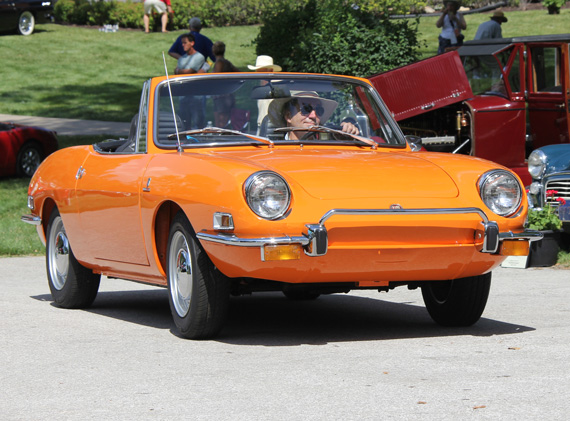
Richard Crump and Kathi Box’s Fiat 850 Spyder drew lots of attention. The color was partly responsible. They say if you lived through the hippie era and can remember it, you weren’t really there. I do recall these little Bertone beauties of the period introducing a whole new generation to the pleasures of motoring in an Italian car. Credit: Bob Dinkins
By Michael T. Lynch
The Eighth Edition of Art of the Car Concours® continued the show’s ascension as a leading automotive event between the two coasts. Both entries and people passing through the show field were records. Last year, the organizers added a Meet the Legends program on Saturday. It was a panel discussion of road racing in the 1950s featuring Sir Stirling Moss, Denise McCluggage and Masten Gregory’s late brother, Riddelle, himself a racer. Held appropriately in an academic amphitheatre at the University of Missouri – Kansas City, the discussion drew well over 300 people.
Leveraging off this success, the program was repeated this year. To celebrate the first time hot rods were entered in the Art of the Car Concours, this year’s panel delineated the history of hot rodding from the 1920s. Panelists were Pete Chapouris, President of the So-Cal Speed Shop and Member of the Hot Rod Hall of Fame, Ken Gross, Museum Consultant, former Director of the Petersen Automotive Museum and author of three books on hot rods. Representing the collector community was Tom McIntyre.
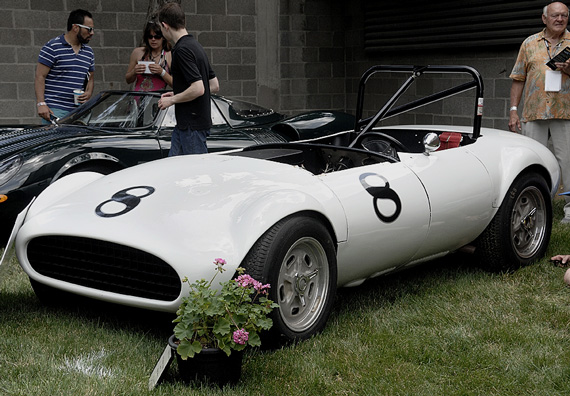
Dick Troutman and Tom Barnes partially assembled and were the pit crew for the Kurtis that won Indianapolis in 1953-54 with Bill Vukovich driving. At a time when there was little interchange between road and oval racing types, they built this Troutman-Barnes Special which won some road races and remained competitive for a few years in Southern California. They then went to work for Lance Reventlow’s Scarab team, building the cars that first beat the foreign cars on a regular basis in U.S. racing. Credit: Bob Brents
Also offering comments during the presentation were collector Richard Munz, who like Gross, has passed from Ferraris to hot rods, builders Ken Schmidt of Rolling Bones Hot Rod Shop and Jerry Slover of Pete and Jake’s Hot Rod Parts, a company once owned by Chapouris. Slover and his family run their business from Peculiar, Missour, thirty miles from Kansas City. Dana Williamson, Collection Manager at the Petersen Museum, was also there, tending to one of his vehicles, the Ray Brown 1932 Ford Roadster.
Since hot rods were once the scourge of the highways and byways during the immediate post-World War II period, there were plenty of interesting stories to tell. After the historic presentation, there was a Q & A period allowing the crowd to question the guests.
Earlier in the week, Ken Gross was interviewed on National Public Radio, accompanied by Art of the Car Concours Chairman, Marshall Miller. You can hear that interview HERE.
Click on listen when you arrive at the page.
An exhibitors’ cocktail party open to the public took place Saturday evening at the campus of the Kansas City Art Institute. This four-year college of design and fine arts, dating to 1887, is the sole charity of the Art of the Car Concours, and the event is held on their scenic campus. At a college with a very high percentage of students receiving financial aid, the funds provided by the Art of the Car Concours are more than welcome.
Sunday was warm and sunny and the crowds streamed through the gates to see the 220 cars assembled on the show field. Each concours has to establish its own character and the Art of the Car Concours is unusual in that there are no classes and no judges. The cars are placed on the field randomly. Exhibitors are thus freed of the deep seated fear that their right rear tail light might not operate when their car is being judged. This obviously makes for a much more relaxed atmosphere. Awards are chosen by sponsors, the public and the organizers. The awards are designed by Kansas City Art Institute faculty and alumni. The vehicles range from pre-war Grand Classics, to motorcycles, sports cars, exotics and pedal cars. This year there was a Unimog and two tractors. There is even an award for the Best 100 Year Old Vehicle and another for families who enter cars owned by different generations.
I was scheduled to announce, and enlisted Ken Gross to partner because of his expertise. The two of us cruised the field in search of owner interviews, while my wife, Vicki, followed us with a sign on a pole that said, “Live Interviews” so the crowd could locate the cars that were being talked about.
As usual, the variety of cars was almost overwhelming. Another neat feature was the Hagerty Youth Judging experience. Twenty young people, both male and female, were able to interface with exhibitors, people with judging experience and restorers, where they learned about what makes certain cars special. The program is designed to foster a new generation of collectors and connoisseurs. I was able to interview one of the participants, Alex Zugazagoitia, who enjoyed the whole experience. He is already a budding enthusiast and allowed that he learned quite a bit about cars. The young participants gave the Hagerty Youth Judging Experience Award to Darren Abbott’s Packard 920 Standard Eight Roadster Coupe.
If you would like to see the winners of the thirty some awards given, go HERE
People’s Choice went to Denis Kiefer’s Lincoln KB Brunn Semi-collapsible Cabriolet, which also won the Branson Collector Car Auction “Gatsby” Award. The two Chairman’s Awards were given to Dave Geisler’s FIAT 60 Touring and Tom McIntyre’s 1932 Ford Three Window hot rod built by Rolling Bones.
Thanks To:
Events like this cannot take place without volunteers and those taking part did a fabulous job of making the day run smoothly for both exhibitors and spectators.
Special thanks also go our presenting sponsor, the Mercedes Dealers of Kansas City – Aristocrat Motors and Mercedes-Benz of Kansas City.
As he did last year, Kansas City’s leading automotive journalist, Tom Strongman, both assembled and ran the slide show for the Meet the Legends presentation and helped publicize the event in many ways.
The local and national hot rod community allowed us to assemble one of the finest groups of historic and period correct hot rods outside a rod only show.
Finally, congratulations are in order for Ken Gross, who was recently awarded a Distinguished Service Citation from the Automotive Hall of Fame. It will be given at an induction ceremony at the museum in Dearborn on July 24th.
Scroll down for many more photos and captions

This Italian-inspired but all American hot rod was born out of Charles Little’s admiration for the Maserati 8CTF that Wilbur Shaw used to win the Indianapolis 500 in 1939 and 1940. Little shaped the grille after the Maserati. The frame is Ford and the power is from a 50s Dodge Red Ram Hemi. It is whimsically named Maserodi 8CTVR. Credit: Bob Dinkins
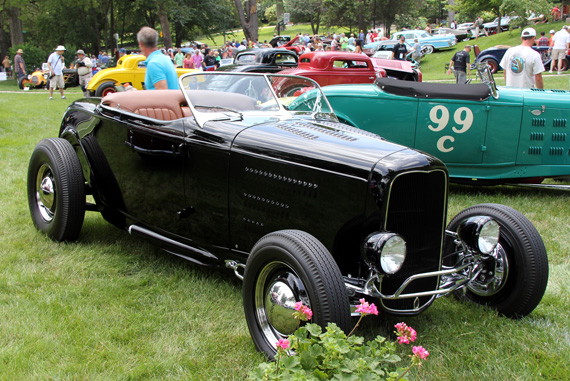
Pebble Beach 2007 was a momentous day for hot rods. For the first time, the world’s greatest concours, Pebble Beach, had a class for them. After seeing their workmanship, some collectors felt that a well-rounded collection should have one of these examples of American folk art, and acted accordingly. Bruce Meyer’s Doane Spencer 1932 Ford Roadster (above) was winning prizes back in 1947 and took First in the Historic Hot Rod Class that day at Pebble Beach. Credit: Bob Dinkins
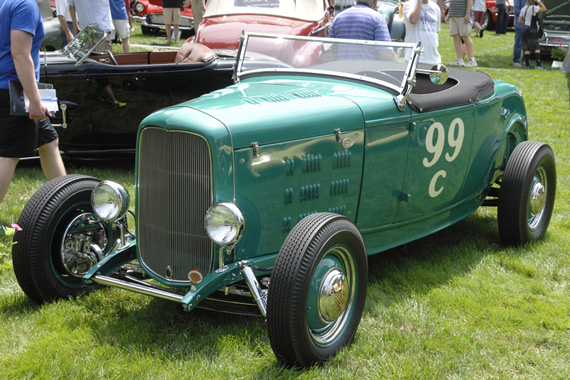
Second at Pebble Beach in 1997 was the Petersen Museum’s Ray Brown ’32. Both these cars were together again at the 2014 Art of the Car Concours. Credit: Bob Brents

Tom McIntyre’s chopped 1932 Ford Three Window Coupe won a Chairman’s Award at the concours. It was built by Ken Schmidt and his crew at Rolling Bones Hot Rod shop outside Saratoga Springs, New York and is powered by a 1950s Dodge Red Ram Hemi. Rolling Bones is known for period correct construction and almost instant patina. Note the faded race number on the door. When McIntyre picked up the car after its build, he drove it to Bonneville, and from there continued on to the Rolex Monterey Motorsports Reunion. Like many collectors today, his interest does not stop with hot rods. The trip west must have been like looking through a letterbox slot. Behind it with the flame job is another famous hot rod built by Pete Chopouris in the 1970s. It is known as The California Kid, after a movie it was in featuring Martin Sheene, Michelle Phillips and Nick Nolte. When Jerry Slover bought Chapouis’ company, Pete and Jake’s Hot Rod Parts, the car came with the sale. The company was moved to Peculiar, Missouri, thirty miles from Kansas City. The car won the Heritage Tow 'Vehicle We’d Most Like to Tow' Award, as well as the Weld Racing 'KC Quarter Mile Krusher' Award. Credit: Bob Brents.
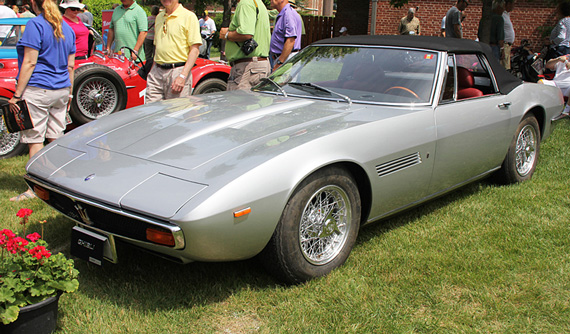
Steven Koenig’s Maserati Ghibli was one of the great supercars of the 1960s along with the Ferrari Daytona and the Lamborghini, both of which it outsold. The Spyder is the most desirable of the line with only 125 being built. Credit: Bob Dinkins.
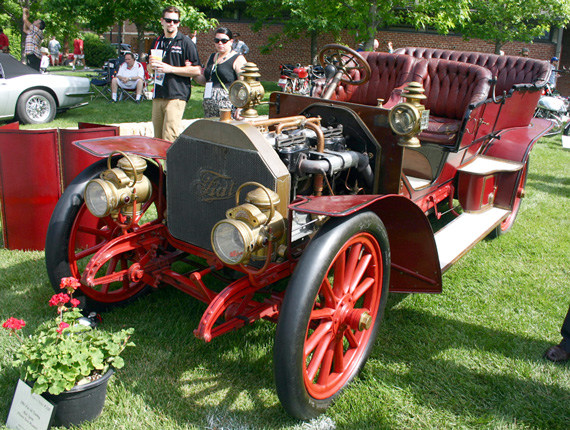
This 1905 FIAT 60 has a great Missouri History. August Anheuser Busch, son of the founder of the Budweiser dynasty was visiting Kaiser Wilhelm of Germany who had purchased a 60 and convinced Busch to buy one. Busch had a chassis shipped and bodied in America by Quimby. Despite their over the top luxury appointments, these were among the fastest road cars of their day and racing versions won both the Targa Florio and the French Grand Prix in 1907. Once the property of Metropolitan Opera Star James Melton, the car now resides in Dave Geisler’s Pioneer Museum in Murdo, South Dakota. It won a Chairman’s Award at the Art of the Car. Credit: Michael T. Lynch
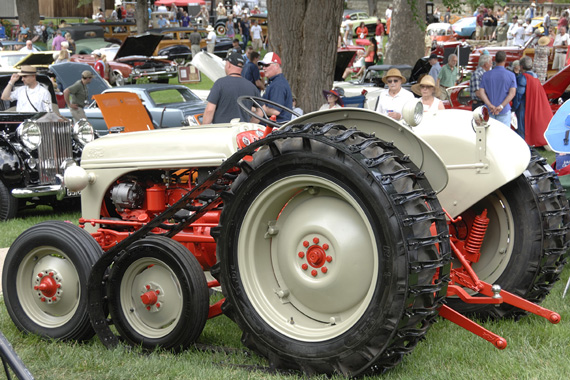
The Art of the Car encourages diversity, from vintage race cars to Unimogs and pedal cars. Robert Vincent’s Ford 8N tractor sports a tank tread, one of dozens of accessories available for different crops, soil conditions, etc. Since there are no classes, the tractor is parked across the aisle from a Rolls-Royce. This was the largest selling tractor model in U.S. history. Although the 8N had enough power for its intended purpose, I don’t think the rear appendages are wheelie bars. Credit: Bob Brents
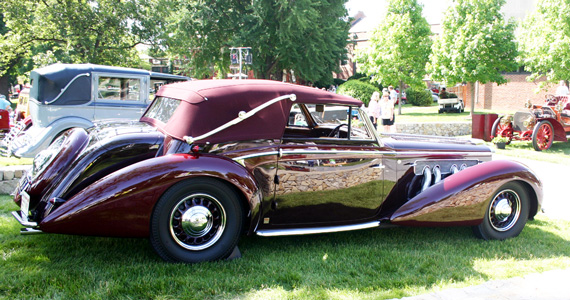
The Mullin Automotive Museum sent this magnificent Delage D8-120 all the way from California. This four-seat cabriolet, with a three position top by bodybuilder Henri Chapron, was made before World War II and belonged to a French General who collaborated with the Germans. After the war he shipped it to the U.S. before finding out that he could not obtain a visa to follow it. The car ended up at RKO Studios in Los Angeles where it was featured in classic American films like An American in Paris, Carmen Jones and The Long Goodbye. The elongated hood, outside exhausts, top landau irons and elegant spare tire treatment are just a few of the styling details that make this a true classic from the era when French automotive design was at its height. Credit: Michael T. Lynch

This DeTomaso Pantera GTS is an example of the last and most sporting of the line to be imported to the U.S. Robert Radefeld’s restoration included all the fixes that have been devised to correct some flaws in the original build quality. These cars, with their Cleveland 351 V-8s, offer a level of performance for the dollar that cannot be replicated. Credit: Bob Dinkins

Bob Peters’ Ducati 350cc Mk 3 had a recent new paint job. Rather than use decals, painter Scott Thomas painted the side trim and Ducati logo by hand. Truly a work of art. Credit: Bob Brents

The interview team with Richard Morrison, whose Lagonda LG45 was one of the highlights of the day. From left, Lynch, Ken Gross, Morrison and Vicki Lynch.

Richard Munz’ full-fendered Neal East 1932 Ford Roadster was a hot rod at least as early as 1954. Bill Woodward made it an early convert from a Ford flathead to a Chevrolet ohv V-8. In this iteration, the car became a feature story in Hot Rod Magazine in February 1958. Woodward later made it into a show car by chroming the entire undercarriage including the driveline. Neal East bought it and used it one the street. It was the cover car on the first full-size issue of Rod and Custom which had previously been Readers’ Digest size. East was a well-known hot rod advocate and was Associate Editor for Rod and Custom for a time. Now living in Denver, he still builds and drives hot rods. The car was later redone to its show car specs and was shown that way at the Art of the Car. Credit: Gary Krings

Thank you Michael T.,
I truly enjoy every where you take us. Your insight and focus on the subtle and special cars, people and places create the occasion right here on this web sight (thanks Pete) The pain of not being there with you is not so great because of the words and pictures you share. Hope to see you up or down the road sometime soon.
sam
Thank you, Michael, for bringing us your comments and photographers’ images of the very special Art of the Cars Concours, with particularly interesting extended picture captions that “put us there” and informed in the best of ways. Of definite delight was the field being not confined to restrictions of categories and judges. Congratulations to you and all involved for an event of charming presence in the world of car love, and to Veloce Today for carrying this story.
Obviously, I have mixed Troutman and Barnes up with Jim Travers and Frank Coon in the caption for the Troutman-Barnes Special. Troutman and Barnes both did work at Frank Kurtis’ shop, but it was Travers and Coon who built and crewed the Vukovich Indy winning car. They did it by canting the engine for a lower car – the driveshaft was to the side, allowing a lower seating position. They should be credited with revolutionizing Indy car design. Either Vukovich or Coon first used the term Indy roadster. I interviewed Coon, but Vukovich was long dead and could not state his position on the subject.
The Troutman-Barnes car beat the foreigners more than once. It began life with a Mercury flathead and later got a Ford ohv Y-block and finally a Chevrolet as modified by the Scarab team, keeping it competitive from 1954 through 1958. It is a milestone on the road to the Scarab, also built by Troutman and Barnes over the winter of 1957-58, which was the first big bore American sports racer to beat the foreign competition on a regular basis.